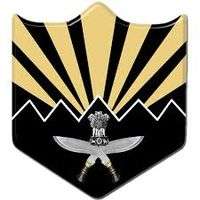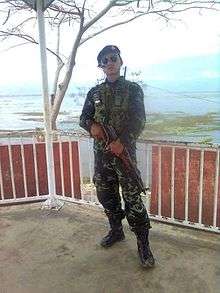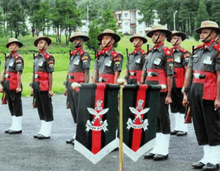Assam Rifles
| Assam Rifles | |
|---|---|
 Coat of arms of the Assam Rifles | |
| Motto | Sentinels of the North East |
| Agency overview | |
| Formed | 1835 |
| Employees | 63,747 Active Personnel[1] |
| Annual budget | ₹5,548.74 crore (US$770 million)(2018–19 est.)[2] |
| Jurisdictional structure | |
| Federal agency | IN |
| Operations jurisdiction | IN |
| Governing body | Ministry of Home Affairs (India) |
| Constituting instrument |
|
| General nature | • Federal law enforcement |
| Headquarters | Shillong, India |
|
| |
| Minister responsible |
|
| Agency executive |
|
| Parent agency | Paramilitary forces of India, Indian Army |
| Website | |
|
assamrifles | |
The Assam Rifles is the oldest of paramilitary force of India. The unit can trace its lineage back to a paramilitary police force that was formed under the British in 1835 called Cachar Levy. Since then the Assam Rifles have undergone a number of name changes—the Assam Frontier Police (1883), the Assam Military Police (1891) and Eastern Bengal and Assam Military Police (1913), before finally becoming the Assam Rifles in 1917.[5] Over the course of its history, the Assam Rifles and its predecessor units have served in a number of roles, conflicts and theatres including World War I where they served in Europe and the Middle East, and World War II where they served mainly in Burma. In the post World War II period the Assam Rifles has expanded greatly as has its role. There are currently 46 battalions of Assam Rifles with a sanctioned strength of 63,747 personnel.[6][7] It is under the control of the Indian Ministry of Home Affairs (MHA) and they perform many roles including the provision of internal security under the control of the army through the conduct of counter insurgency and border security operations, provision of aid to the civil power in times of emergency, and the provision of communications, medical assistance and education in remote areas.[8] In times of war they can also be used as a combat force to secure rear areas if needed. Since 2002 it has been guarding the Indo–Myanmar barrier as per the government policy "one border one force".[9]
History
Early history
The present day Assam Rifles can trace its origins back to a paramilitary force known as Cachar Levy which was established by the British in 1835 in the Assam region. The Assam Rifles boast of being the oldest paramilitary force. With approximately seven hundred and fifty men, this force was formed as a police unit to protect settlements against tribal raids and other assaults as British rule slowly moved towards the north east parts of India.[6]

Despite problems with equipment and training, the contribution of this force in opening the region to administration and commerce was nevertheless quite significant and over time they have become known as the "right arm of the civil and [the] left arm of the military" in the region.[6] In 1870 these existing elements were merged into three Assam Military Police battalions which were spread out in the Lushai Hills (later 1st battalion), Lakhimpur (2nd battalion) and Naga Hills (3rd battalion). A fourth battalion was later formed Imphal in 1915. The first non-British DG of Assam Rifles was Col. Sidhiman Rai, MC.
Since then the name of the force has undergone a number of changes, as have the roles that it has been required to perform. The current director general of Assam Rifles is Lt Gen Shokin Chauhan AVSM, YSM, SM, VSM.[10]
World War I and Interwar Years
During World War I, men from what was then known as the Assam Military Police were part of the Indian forces that fought in Europe and the Middle East. Over three thousand men from the force were provided to the Gorkha regiments of the Indian Army in this time, earning seventy-six gallantry awards during the conflict including seven Indian Order of Merit awards and five Indian Distinguished Service Medals.[6] These men performed with such distinction that the name Assam Rifles was assigned in 1917 as recognition of their part in the war.[6] Elements of the force were also utilised in India during the war, being used to maintain internal security in order to free up troops from the army for use overseas. During this time, the most notable action occurred in 1917 when columns of the Assam Rifles were despatched to Patna, to restore law and order in the riot-torn city.[6]
After the war the force returned to northern India where they were used to maintain security amidst growing civil unrest and disorder. In concert with the British Indian Army, they also undertook a number of expeditions into remote tribal areas along the north-east frontier and into Burma. In 1924 they were sent to Malabar, which was then still part of the Madras Presidency, to carry out operations against the Mopla rebels.[6]
World War II
During World War II, the role of the Assam Rifles evolved once more as they were called upon to undertake even more varied tasks due to their status as both a police and military organisation. This time, however, their service would be undertaken closer to home. After the lightning Japanese advance in 1942, the Assam Rifles fought a number of independent actions behind enemy lines as the task of rear-area defence and rear-guard often fell to them during the Allies retreat into India. Later, as a large influx of refugees fled from the advancing Japanese into India, the Assam Rifles were given the task of managing and organising this mass of humanity.[6]
They also organized a resistance group on the Indo–Burmese border to counter the Japanese invasion and to harass the enemy line of communications. This group became known as "Victor Force" (or sometimes V-Force), and the nucleus of it was formed from platoons made up of men from the Assam Rifles. As part of this force, Assam Rifles platoons were used as covering forces during the latter stages of the Burma Campaign. Other elements fought in the defensive "boxes" around Kohima, whilst another, from the 4th Battalion, trained as airborne troops, was dropped near the Sittang River behind Japanese lines.[8] The 1st Battalion, as part of Lushai Brigade was sent ahead of the rest of the force to provide resistance in the Chin Hills. As a testament to the performance of Assam Rifles men during the war, members of the unit received forty-eight gallantry awards. These included: three MBE's, five Military Crosses, 4 Orders of British India, one Indian Order of Merit, 13 Military Medals, 15 Indian Distinguished Service Medals and 7 British Empire Medals.[6]

Postwar period
Following the end of the war the five Assam Rifles battalions became part of the civil police under the Assam Inspector General of Police.[8] After independence, however, the Indian government assigned the Assam Rifles its own Director General.[6] As the numbers of the force and the number of battalions gradually increased, the rank of the force commander was also upgraded until now it is that of Lieutenant General. The present Director General of the Assam Rifles is Lieutenant General Ranbir Singh AVSM, SM, of the Bihar Regiment.
The role of the Assam Rifles continued to evolve when in 1950 a devastating earthquake hit the Assam region and the force was called in to assist in the reconstruction of the areas and help in the resettlement and rehabilitation of those affected by it.[8] Later the force was once again called to undertake a combat role when, during the 1962 Sino-Indian War elements were used to delay the advancing Chinese forces so that the Indian Army could establish its defence lines.[6] During this time and since then, the Assam Rifles also maintained their peacekeeping role in the northern areas of India in the face of growing tribal unrest and insurgency. In this environment the maintenance of law and order, countering insurgency and reassuring the people of the region became important tasks for the security forces and initially they fell to the Assam Rifles before the Army assumed control, and then later their experience and goodwill in the region was drawn upon in order to assist the army in conducting these tasks.[6] In recognition of the unit's skill in counter insurgency operations, three battalions were deployed on Operation Pawan in Sri Lanka between December 1988 and February 1990.[8]
Through its deployment in what has become known as the "tribal belt", the Assam Rifles have developed an ethos that is based primarily upon the notion of extending the hand of friendship with the people of the region despite the troubles that have occurred there.[6] This has resulted in their employment in a number of developmental activities in the region as they have worked to bring order and security to it. As such, their role has been further expanded to include the provision of medical assistance and basic education, assisting in reconstruction and agriculture and handling communications in remote areas.
From a force of five battalions in 1947, the Assam Rifles has grown substantially over the years. In 1960 there were seventeen battalions, in 1968 there were twenty-one and today there are forty-six battalions.[8] In addition, the force has several area HQs, a training centre that processes up to 1,800 recruits at time, and a number of logistics units.[11]
Decorations
Members of the Assam Rifles have received the following military decorations since Indian independence:
| Award | Times awarded |
|---|---|
| Ashoka Chakra | 4 |
| Vir Chakra | 5 |
| Kirti Chakra | 31 |
| Shaurya Chakra | 120 |
| Param Vishisht Seva Medal | 5 |
| Ati Vishisht Seva Medal[12] | 12 |
| Sena Medal[13] | 188 |
| Vishisht Seva Medal[14] | 74 |
| Yudh Seva Medal | 1 |
| Mention in Dispatches | 10 |
- N.B. Prior to Indian independence members of the Assam Rifles were eligible for British decorations. During World War I and World War II members of the Assam Rifles received many such awards for their actions, although these have not been included here. There have also been numerous civil awards to members of the Assam Rifles. These can be found at the source listed above.
Director General Assam Rifles
The Director General Assam Rifles (DG AR) is the head of the Assam Rifles. The DG AR has their office in the Headquarters DGAR at Shillong. Appointed by the Government of India, the DG AR reports to the Minister of Home. The Director General is an Indian Army officer of the rank of Lieutenant General and is assisted by three Inspector Generals, each holding the rank of a Major General, and other senior officers heading various staff appointments. The Additional Director General of the Assam Rifles who is a Major General ranked officer serves as the second-in-command to the Director General.
List of DGAR
The first Director General post-Independence was Mr HG Bartly who assumed the appointment on 17 Sep 1947. First Indian Director General was Colonel Sidhiman Rai, MC appointed on 15 August 1948. The rank of officers holding the appointment of Director General Assam Rifles has been consistently upgraded from Colonel to Brigadier (1-Star General) to Major General (2-Star General) to Lieutenant General (3-Star General) now. Indian Army officers on deputation have been holding the appointment of Director General Assam Rifles till date. The current Director General Lt Gen Shokin Chauhan, AVSM, YSM, SM, VSM is the 30th DGAR. The list of Director General Assam Rifles till date is as follows.
| No | Name | Appointment Date | Till |
|---|---|---|---|
| 1 | Mr HG Bartly, CIE, IP | 17 Sep 1947 | 14 Aug 1948 |
| 2 | Colonel Sidhiman Rai, MC | 15 Aug 1948 | 10 Dec 1949 |
| 3 | Colonel RND Frier, MC | 16 Dec 1949 | 29 Feb 1952 |
| 4 | Brigadier K Bhagwati Singh, AVSM | 01 Mar 1952 | 4 May 1954 |
| 5 | Brigadier K S Katoch, MC | 5 May 1954 | 29 Aug 1955 |
| 6 | Brigadier Harbhajan Singh | 07 Sep 1955 | 30 Nov 1957 |
| 7 | Maj Gen AS Guraya | 01 Feb 1958 | 14 Dec 1965 |
| 8 | Maj Gen SN Bhatia | 15 Dec 1965 | 15 Feb 1968 |
| 9 | Maj Gen VB Tuli | 20 Feb 1968 | 19 May 1972 |
| 10 | Maj Gen MG Hazari, PVSM, AVSM | 30 Mar 1973 | 29 Feb 1976 |
| 11 | Maj Gen (Later Lt Gen) K Chiman Singh, PVSM | 01 Mar 1976 | 25 Jun 1979 |
| 12 | Lt Gen Sushil Kumar, PVSM | 01 Sep 1979 | 02 Dec 1981 |
| 13 | Lt Gen JK Puri, PVSM, AVSM | 02 Dec 1981 | 29 Nov 1983 |
| 14 | Lt Gen PE Menon, PVSM | 30 Nov 1983 | 31 May 1987 |
| 15 | Lt Gen MK Lahiri, PVSM | 01 Jun 1987 | 21 Dec 1989 |
| 16 | Lt Gen RV Kulkarni, PVSM, UYSM, AVSM | 22 Feb 1990 | 09 Mar 1992 |
| 17 | Lt Gen VP Airy, MVC | 18 Mar 1992 | 31 Mar 1993 |
| 18 | Lt Gen YM Bammi, ADC | 15 Jul 1993 | 30 Apr 1995 |
| 19 | Lt Gen TPS Rawat, PVSM, VSM | 19 May 1995 | 30 Apr 1998 |
| 20 | Lt Gen Gurpreet Singh, PVSM | 1 May 1998 | 18 Jan 2001 |
| 21 | Lt Gen GK Duggal, PVSM, AVSM, VrC | 19 Jan 2001 | 18 Jan 2003 |
| 22 | Lt Gen HS Kanwar, PVSM, AVSM, VSM | 01 Mar 2003 | 30 Apr 2004 |
| 23 | Lt Gen Bhopinder Singh, PVSM, AVSM, VSM | 1 May 2004 | 30 Jun 2006 |
| 24 | Lt Gen Paramjit Singh, PVSM, AVSM, VSM | 06 Jul 2006 | 31 May 2008 |
| 25 | Lt Gen KS Yadava, PVSM, AVSM, SM, VSM | 09 Jun 2008 | 30 Sep 2010 |
| 26 | Lt Gen Rameshwar Roy, UVSM, AVSM, YSM | 06 Dec 2010 | 22 Feb 2012 |
| 27 | Lt Gen Ranbir Singh, PVSM, AVSM, SM | 27 Aug 2012 | 31 Mar 2014 |
| 28 | Lt Gen R K Rana, SM, VSM | 26 May 2014 | 31 Aug 2015 |
| 29 | Lt Gen H J S Sachdev, PVSM, AVSM, SM, ADC | 01 Sep 2015 | 30 Sep 2016 |
| 30 | Lt Gen Shokin Chauhan, AVSM, YSM, SM, VSM | 12 Dec 2016 | 31 Mar 2018 |
Rank Structure
| Assam Rifles ranks | Equivalent Army ranks |
|---|---|
| Director General (Army officer on deputation) | Lieutenant General |
| Inspector General (Army officer on deputation) | Major General |
| Deputy Inspector General (Army officer on deputation) | Brigadier |
| Commandant (Army Officer on deputation) | Colonel |
| Second in Command | Lieutenant Colonel |
| Deputy Commandant | Major |
| Assistant Commandant | Captain |
See also
References
Notes
- ↑ "Archived copy" (PDF). Archived from the original (PDF) on 8 August 2017. Retrieved 12 August 2017.
- ↑ http://www.indiabudget.gov.in/ub2018-19/eb/sbe48.pdf
- ↑ "Lt Gen Sukhdeep Sangwan is the new Director General of Assam Rifles". 14 May 2018.
- ↑ "Lt Gen Sukhdeep Sangwan takes over as DG of Assam Rifles". 14 May 2018.
- ↑ See Sharma 2008.
- 1 2 3 4 5 6 7 8 9 10 11 12 13 See History of the Assam Rifles Archived 10 March 2009 at the Wayback Machine.
- ↑ "MHA Annual Report 2016-2017" (PDF). Archived from the original (PDF) on 8 August 2017.
- 1 2 3 4 5 6 Sharma 2008.
- ↑ "One Border One Force?". outlookindia.com.
- ↑ Bureau, News Mobile State (2016-12-14). "Lt. Gen Shokin Chauhan takes over as DG Assam Rifles - Newsmobile". Newsmobile. Retrieved 2017-10-15.
- ↑ See Assam Rifles Training Centre Archived 9 March 2009 at the Wayback Machine..
- ↑ There has been one instance of a multiple award of the AVSM to the same recipient, that is a Bar being awarded. This is included in this figure.
- ↑ There have been four Bars awarded for the Sena Medal to members of the Assam Rifles. These are included in this figure.
- ↑ There has been one instance of a Bar being awarded for the VSM to a member of the Assam Rifles. This has been included in this figure.
- ↑ (Source: Assam Rifles Honours and Awards Archived 6 May 2008 at the Wayback Machine.).
- ↑ "Archived copy" (PDF). Archived from the original (PDF) on 4 April 2012. Retrieved 3 October 2011.
- ↑ "Archived copy". Archived from the original on 10 April 2009. Retrieved 10 April 2009.
- ↑ Archived 20 November 2010 at the Wayback Machine.
- ↑ "Govt Agrees to 'Pay Hike Demand' for Lt Cols". news.outlookindia.com. Archived from the original on 15 July 2012. Retrieved 12 February 2013.
- ↑ "Error Page".
- ↑ Archived 21 July 2011 at the Wayback Machine.
- ↑ "Updates on 6th CPC". Pcdaopune.gov.in. Retrieved 12 February 2013.
Bibliography
- Parker, John. (2005). The Gurkhas: The Inside Story of the World's Most Feared Soldiers. Headline Book Publishing. ISBN 978-0-7553-1415-7.
- "History of the Assam Rifles". Retrieved 25 February 2009. Available at: https://web.archive.org/web/20090310015024/http://assamrifles.net/site/aboutus.htm.
- "Assam Rifles Training Centre". Retrieved 25 February 2009. Available at: https://web.archive.org/web/20090309031319/http://assamrifles.net/site/training.htm.
- Shakespear, Leslie. (1929). History of the Assam Rifles. Macmillan: London. Reprinted in 1977 by Firma.
- Sharma, A.K. (2008). "The Assam Rifles: Sentinels of the East". 16 May 2008. Retrieved 25 February 2009. Available at: https://web.archive.org/web/20080519152847/http://frontierindia.net/the-assam-rifles-sentinels-of-the-east.
